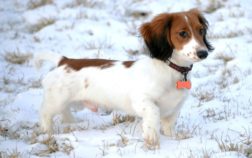Are you curious about the size of a Dachshund? Well, look no further! In this article, we will explore just how big these adorable little dogs can get. From their height to their weight, we will delve into the different sizes and variations of this beloved breed. Whether you’re considering getting a Dachshund for your family or simply want to satisfy your curiosity, this article will provide you with all the essential information you need. So, let’s jump right in and discover just how big these lovable canines can become.
Dachshund Size
Overview of Dachshund size
Dachshunds are a unique and popular breed known for their long bodies and short legs. When considering getting a Dachshund as a pet, understanding their size is essential. Dachshunds come in three main sizes: Standard, Miniature, and Toy. Each size has its own set of characteristics and considerations. In this article, we will explore the average height and weight of each Dachshund size, variations within each breed, and factors that influence their growth.
Factors influencing Dachshund size
Several factors can influence the size of a Dachshund, regardless of their breed. These factors include genetics and breed lineage, nutrition and diet, exercise and physical activity, health and medical conditions, as well as the effects of spaying or neutering on growth. Understanding these factors can help Dachshund owners anticipate and manage the size of their furry companions.
Standard Dachshund Size
Average height and weight of Standard Dachshunds
Standard Dachshunds are the largest size variation of the breed. On average, they stand between 8 to 9 inches tall at the shoulder and weigh between 16 to 32 pounds. However, it’s important to note that these are general guidelines, and individual Dachshunds may vary slightly in size.

Size variations within the Standard Dachshund breed
Even among Standard Dachshunds, there can be some size variations. Within the breed, you may find individuals that are slightly taller or heavier than the average range. It is essential to consider factors such as genetics and breeding when looking for a Standard Dachshund, as these can influence the size of the dog you bring home.
Miniature Dachshund Size
Average height and weight of Miniature Dachshunds
Miniature Dachshunds are the medium-sized variation of the breed. On average, they stand between 5 to 7 inches tall at the shoulder and weigh between 9 to 11 pounds. While smaller than Standard Dachshunds, Miniature Dachshunds still possess the same lovable traits and playful nature that make the breed so popular.
Size variations within the Miniature Dachshund breed
Just like Standard Dachshunds, there can be some size variations within the Miniature Dachshund breed as well. Some individuals may fall slightly outside the average height and weight range. It’s crucial to consult with reputable breeders who can provide information about their breeding practices and the expected size of the Miniature Dachshund puppies they offer.
Toy Dachshund Size
Average height and weight of Toy Dachshunds
Toy Dachshunds are the smallest size variation of the breed. On average, they stand between 4 to 6 inches tall at the shoulder and weigh between 8 to 9 pounds. These tiny bundles of joy are incredibly adorable and well-suited for individuals or families looking for a compact and portable pet.

Size variations within the Toy Dachshund breed
Although Toy Dachshunds have a relatively consistent size, there can still be slight variations among individuals. Some might be smaller or lighter than the average range. If you are specifically looking for a Toy Dachshund, it’s important to find a reputable breeder who can provide accurate information about the expected size of their puppies.
Growth Stages of Dachshunds
Puppy stage and estimated growth rate
Like all dogs, Dachshunds go through several growth stages as they develop from puppies to adults. During the puppy stage, Dachshunds experience rapid growth. Their bones, muscles, and organs are still developing, and they require appropriate nutrition and care to support their growth. It is crucial to provide a balanced diet and regular veterinary check-ups to ensure their healthy development.
Teenage stage and physical changes
As Dachshunds transition into their teenage stage, their growth rate starts to slow down. This stage is characterized by the maturation of their bodies and physical changes such as the development of adult teeth and sexual maturity. It is essential to continue providing proper nutrition and monitor their overall health as they go through these changes.
Adult stage and final size
By the time Dachshunds reach adulthood, their growth has typically stabilized. Their bodies have fully developed, and they have reached their final size. It’s essential to remember that while size variations within the breed exist, the average height and weight we discussed earlier are typically indicative of an adult Dachshund’s size.
Factors Influencing Dachshund Growth
Genetics and breed lineage
Genetics play a significant role in determining a Dachshund’s size. The size of their parents and lineage can provide insights into the expected growth of a Dachshund puppy. Reputable breeders carefully select breeding pairs to ensure healthier and more predictable size outcomes for their litters.
Nutrition and diet
A well-balanced diet is crucial for proper growth and development in Dachshunds. Providing a high-quality dog food that meets their specific nutritional needs is essential. Overfeeding or underfeeding can lead to growth abnormalities and potential health issues. Consulting with a veterinarian can help determine the appropriate diet and feeding schedule for your Dachshund.
Exercise and physical activity
Regular exercise and physical activity are important for maintaining a healthy weight and overall well-being in Dachshunds. Engaging your Dachshund in activities such as daily walks, playtime, and mental stimulation not only promotes physical growth but also strengthens their muscles and joints.
Health and medical conditions
Certain health conditions can affect a Dachshund’s growth and overall size. Conditions such as hypothyroidism or metabolic disorders can cause weight fluctuations and affect their growth rate. Regular veterinary check-ups and prompt treatment of any underlying health issues are essential to ensure proper growth and development.
Spaying or neutering effects on growth
Spaying or neutering your Dachshund can potentially impact their growth. While the procedure itself does not directly influence size, it can affect metabolism and hormone levels, which may lead to weight gain or a slower growth rate. Consulting with a veterinarian regarding the timing and potential effects of spaying or neutering can help you make informed decisions for your Dachshund.
Dachshund Growth Chart
Overview of a Dachshund growth chart
A Dachshund growth chart is a helpful tool that provides a visual representation of the average growth patterns for the breed. It typically includes the expected height and weight ranges at different stages of a Dachshund’s development, from puppyhood to adulthood.
How to use a Dachshund growth chart
To use a Dachshund growth chart, you need to record your Dachshund’s current measurements and compare them to the corresponding age and weight ranges on the growth chart. This can give you a general idea of whether your Dachshund is growing within the expected range or if there are any concerns that warrant further attention.
Limitations of a Dachshund growth chart
It is essential to remember that a Dachshund growth chart provides average ranges and is not an exact science. Individual Dachshunds may deviate slightly from these ranges without any underlying issues. Additionally, factors such as genetics and breed lineage can influence growth, making it crucial to consider these factors alongside the growth chart.
Size Comparisons with Other Breeds
Dachshund size compared to other small dog breeds
Compared to other small dog breeds, Dachshunds fall within a similar size range. They are typically smaller than medium-sized dog breeds but larger than toy breeds like Chihuahuas or Yorkshire Terriers. However, it’s important to remember that there can still be size variations among individuals within each breed.
Dachshund size compared to medium and large dog breeds
When comparing Dachshunds to medium and large dog breeds, they are considerably smaller in size. Breeds such as Labrador Retrievers and German Shepherds are much larger and heavier. Dachshunds’ smaller size makes them well-suited for individuals or families living in smaller spaces.
Size Considerations for Dachshund Owners
Living conditions and space requirements
Dachshunds are adaptable dogs and can comfortably live in apartments or houses with limited space. However, it’s important to provide them with enough room to exercise and play. Regular walks and access to an outdoor area for bathroom breaks are essential for their well-being.
Travel and transportation considerations
Dachshunds’ smaller size makes them easier to transport compared to larger dog breeds. They can be comfortably accommodated in carriers or crates during car rides or flights. However, it’s crucial to ensure their safety and provide them with a secure and comfortable space during travel.
Exercise and playtime needs
Despite their small size, Dachshunds still require regular exercise and playtime to keep them happy and healthy. Daily walks, interactive toys, and mental stimulation are important for their physical and mental well-being. Keep in mind that Dachshunds have a strong hunting instinct, so providing activities that tap into their natural instincts can greatly enrich their lives.
Feeding and healthcare considerations
Proper nutrition and regular veterinary care are essential for Dachshunds of all sizes. It’s important to feed them a balanced diet, monitor their weight, and schedule regular check-ups to detect any potential health issues early on. Dental care is also crucial, as Dachshunds are prone to dental problems due to their small mouths and crowded teeth.
Conclusion
Summary of typical Dachshund sizes
Dachshunds come in three main sizes: Standard, Miniature, and Toy. Standard Dachshunds are the largest, with an average height of 8 to 9 inches and a weight range of 16 to 32 pounds. Miniature Dachshunds are medium-sized, standing at 5 to 7 inches tall and weighing between 9 to 11 pounds. Toy Dachshunds are the smallest, measuring 4 to 6 inches in height and weighing around 8 to 9 pounds.
Importance of understanding Dachshund size variations
Understanding the size variations within the Dachshund breed is crucial for potential Dachshund owners. It allows them to choose a size that suits their living conditions and lifestyle. By having an idea of the expected size of a Dachshund, owners can better prepare for their pet’s care, including exercise, feeding, and healthcare needs.
Responsibilities of Dachshund owners regarding size considerations
As a Dachshund owner, it is your responsibility to provide appropriate care for your furry friend, regardless of their size. This includes regular veterinary check-ups, a balanced diet, exercise and playtime, and a safe and loving environment. By understanding the factors that influence Dachshund growth and size, you can ensure that your Dachshund thrives and leads a happy and healthy life.




